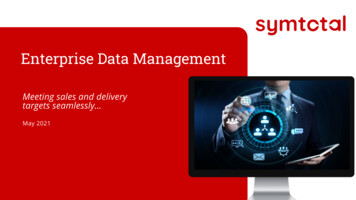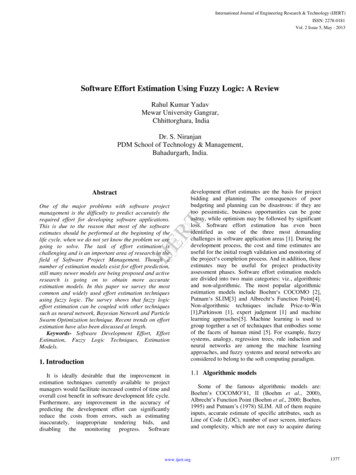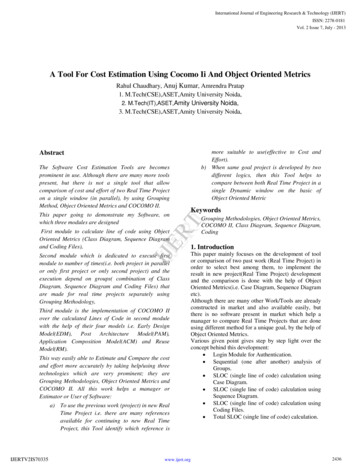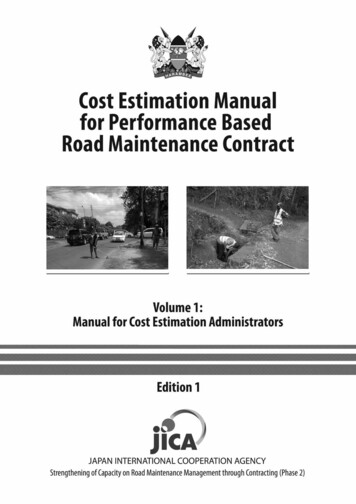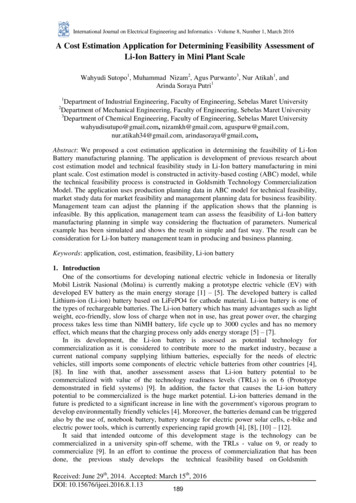
Transcription
International Journal on Electrical Engineering and Informatics - Volume 8, Number 1, March 2016A Cost Estimation Application for Determining Feasibility Assessment ofLi-Ion Battery in Mini Plant ScaleWahyudi Sutopo1, Muhammad Nizam2, Agus Purwanto3, Nur Atikah1, andArinda Soraya Putri112Department of Industrial Engineering, Faculty of Engineering, Sebelas Maret UniversityDepartment of Mechanical Engineering, Faculty of Engineering, Sebelas Maret University3Department of Chemical Engineering, Faculty of Engineering, Sebelas Maret Universitywahyudisutupo@gmail.com, nizamkh@gmail.com, aguspurw@gmail.com,nur.atikah34@gmail.com, arindasoraya@gmail.com,Abstract: We proposed a cost estimation application in determining the feasibility of Li-IonBattery manufacturing planning. The application is development of previous research aboutcost estimation model and technical feasibility study in Li-Ion battery manufacturing in miniplant scale. Cost estimation model is constructed in activity-based costing (ABC) model, whilethe technical feasibility process is constructed in Goldsmith Technology CommercializationModel. The application uses production planning data in ABC model for technical feasibility,market study data for market feasibility and management planning data for business feasibility.Management team can adjust the planning if the application shows that the planning isinfeasible. By this application, management team can assess the feasibility of Li-Ion batterymanufacturing planning in simple way considering the fluctuation of parameters. Numericalexample has been simulated and shows the result in simple and fast way. The result can beconsideration for Li-Ion battery management team in producing and business planning.Keywords: application, cost, estimation, feasibility, Li-ion battery1. IntroductionOne of the consortiums for developing national electric vehicle in Indonesia or literallyMobil Listrik Nasional (Molina) is currently making a prototype electric vehicle (EV) withdeveloped EV battery as the main energy storage [1] – [5]. The developed battery is calledLithium-ion (Li-ion) battery based on LiFePO4 for cathode material. Li-ion battery is one ofthe types of rechargeable batteries. The Li-ion battery which has many advantages such as lightweight, eco-friendly, slow loss of charge when not in use, has great power over, the chargingprocess takes less time than NiMH battery, life cycle up to 3000 cycles and has no memoryeffect, which means that the charging process only adds energy storage [5] – [7].In its development, the Li-ion battery is assessed as potential technology forcommercialization as it is considered to contribute more to the market industry, because acurrent national company supplying lithium batteries, especially for the needs of electricvehicles, still imports some components of electric vehicle batteries from other countries [4],[8]. In line with that, another assessment assess that Li-ion battery potential to becommercialized with value of the technology readiness levels (TRLs) is on 6 (Prototypedemonstrated in field systems) [9]. In addition, the factor that causes the Li-ion batterypotential to be commercialized is the huge market potential. Li-ion batteries demand in thefuture is predicted to a significant increase in line with the government's vigorous program todevelop environmentally friendly vehicles [4]. Moreover, the batteries demand can be triggeredalso by the use of, notebook battery, battery storage for electric power solar cells, e-bike andelectric power tools, which is currently experiencing rapid growth [4], [8], [10] – [12].It said that intended outcome of this development stage is the technology can becommercialized in a university spin-off scheme, with the TRLs - value on 9, or ready tocommercialize [9]. In an effort to continue the process of commercialization that has beendone, the previous study develops the technical feasibility based on GoldsmithReceived: June 29th, 2014. Accepted: March 15th, 2016DOI: 10.15676/ijeei.2016.8.1.13189
Wahyudi Sutopo, et al.commercialization model, by mapping the correlation of technical feasibility and the TRLsconcept, assessing the feasibility of the technology can be made with minimum value is equalto 80% of the fulfillment of the indicators for each stage of TRLs, resulted the technicalfeasibility can meet the 7th level of TRLs. [13].In addition, it said that in the technology development phase, according to the Goldsmithcommercialization model, price identification should be studied before proceeding to the nextstage of commercialization [14]. Therefore, previous study develops a cost estimation model toassess the feasibility of developed product based on the suitability of the targeted cost bymarket with the estimated cost, it approaches to develop the model is parametric method basedon activity-based costing and made to enhance accuracy of the cost estimation [14]. Byproviding a numerical example into the model, it can predict the cost of lithium ion battery cell(30Ah) and the feasibility assessment carried out by calculating the targeted cost from desireprofit and targeted price of market, which the targeted cost is calculated as the cut off value toassess the feasibility of the developed product and the developed product feasible, if theestimated cost is equal or less than the targeted cost [14].This paper proposes the development of application based on the model have beendeveloped [14] to calculate the estimated cost needed in production, since the cost estimationmodel is quite difficult for common people. The application will be built in Microsoft Excel.Management team of Li-Ion Battery mini plant can use the application to assess the feasibilityof the production planning in simpler way.2. A Cost Estimation ModelA cost estimation model has been constructed in previous study [14]. As a technicalfeasibility tool, the model has ben considered international standarization in manufacturing Liion battery [13]. Standard from International Electrotechnical Comission (IEC) and UnitedNation (UN) are apllied in this manufacturing scale. Example of the components that has beenstandardized are nickel system, cell testing, cell charging and short circuit.In previous study, they divide into three major topics, namely parametric cost estimationmodel, numerical example and the feasibility assessment [14]. In this section, we discuss aboutthat topics.A. Parametric Cost Estimation ModelThey use parametric cost estimation as an approach based on mathematical equation thatuse relationship between product costs and limited number of parameters [2][15]. Theproduction cost Li-ion battery is calculated using the development of basic cost estimationmodel. To construct the cost estimation model, firstly identify BOM and composition of cost.1. Bill of Material: The first step to develop the cost estimation model is identifying theBOM of lithium ion battery. BOM tree structure of Li-ion battery by previous study shows inFig. 2. The Li-ion battery is a parent product that located at level of 0. The components of Liion battery are devided until four level number [14].190
A Cost Estimation Application for Determining Feasibility AssessmentFigure. 2. The bill of material [14]2. Identification the Composition of Cost: Identification of the composition cost is the nextstep after the BOM defined. At this step, reference [16] and [17] is used to identify thecomposition of the Li-ion EV battery manufacturing cost in large scale. Both of referencepresents breakdown of battery manufacturing costs. Reference [16] shows the percentagebreakdown cost of the Li-ion battery manufacturing for Light-duty vehicles (LDVs) applicationbased on activity as cost drivers, and reference [17] shows the modelling of battery packmanufacturing cost for automotive application based on the type of costs [14]. The costbreakdowns based on the cost type of the manufacturing battery costs in reference [16] and[17] is shown in Table 1.Table 1. The Cost Breakdowns of Li-Ion Ev BatteryCost Breakdowns[17][18]Material39%50.0%Complementary Material37%15.8%Direct labor1%4.3%Overhead1%3.5%General & Administration Cost 2%4.2%Research & Development4%3.6%Depreciation6%9.0%Desire Profit4%4.1%Warranty6%5.3%Source: [14]3. The Cost Estimation Model: In previous study, the development of activity basedcosting to parametric cost estimation model, beginning with define the general activities, whichdriver costs based on the type of cost that identified before. Furthermore the identification ofthe cost center of each activity should be done to be able to build the model. The identificationof general activities that driver costs is shown in Table 2 and the identification of the costcenters of each activity is shown in Table 3.191
Wahyudi Sutopo, et al.Table 2. The General Activities In Li-Ion Battery Development PhaseCost ClassificationComponent of CostActivitiesDirect laborLi-ion battery productionVariable costMaterialPurchases of materials and componentsOverheadLi-ion battery productionR&DResearch by InventorProcurementProcurement of machinery and equipmentFixed costTesting & SafetyTesting and quality control of productGeneral & Adm.Administration activities & equipmentSource: [14]After the cost component for Li-ion battery composed from cost center above, theparametric cost estimation model can be built. All of equation is adopted from previous study[14]. Equation (1) below generated to calculate total cost of battery based on cost center. All ofcost parameters are measured in Indonesia Domestic Rupiah (IDR).(1)TC : Total cost of Li-ion battery (IDR)CCoi: Cost of components no i (IDR)i : refers to component of cost as in Table 3.i {1, 2, 3, 4, 5, 6, 7}Each components of cost (CCoi) have different cost formulation. The variable cost areconsist of direct labor, material and overhead cost. Total cost of direct labor is shown inEquation (2). The direct labor cost formulated based on work hours of researchers students,whose have a duty to produce Li-ion cell battery on laboratory scale. On the other hand, thetotal cost of material, as in Equation (3), is formulated by scale of production of Li-ion batteryand material cost of product as a cost centers.(2)CCo1: Cost of direct labor (IDR)hi : Work hours of research student i (hours)CRsi: Cost driver rate of Research student i (IDR/hours)i : Number of researchers students(3)CCo2: Cost of material (IDR)Qi : Number of cell in day iCm: Material cost of a cell Li-ion batteryTCami: Total cost of auxiliary material in day i (IDR)i : Days of productionOverhead costs are operational costs of production that are not directly related toproduction activities such as material costs and indirect labor and maintenance costs over theproduction activity. Based on the identification of activity and cost center, the estimates modelof overhead cost is based on the machining time, with assessment of overhead rates based onthe raw materials. Overhead rates assess with material costs, because these costs are the largestpercentage of total cost as in reference[16] and [17]. Equation (4) shows the overhead costformulation.192
A Cost Estimation Application for Determining Feasibility ixed Cost567Table 3. The Cost Center of Each Activity Cost DriverComponent ofActivity CostCost CentersCostsDrivers (ACD)Direct laborWork hoursResearchers & studentsMaterialScale of production Material costsOverheadMachining timeOverhead ratesCoordinator team &R&DWork hoursresearchersDelivery & installationProcurementNumber of orderscostsTesting & Safety Number of testingTesting & safety ratesGeneral & AdmWork hoursAdministration teamSource: [14](4)CCo3: Overhead cost (IDR)Tmi: Machining time in day i (hours)OHt: Overhead rates (IDR/hours)i : Days of productionAfter the model to estimate the cost variables have been developed, the next step isfollowed by the development of fixed cost estimation model. The fixed cost are consist ofresearch and development (R&D) cost, procurement cost, testing & safety cost, and the last isgeneral and administration cost. Total cost of R&D is shown in Equation (5). The R&D costformulated based on work hours of coordinator team and researchers. On the other hand, thetotal cost of procurement, as in Equation (6), is formulated by number of order and deliveryand installation cost.(5)CCo4: Cost of R&D (IDR)hi : Work hours of researcher i (hours)CRi: Cost driver rate of Researcher i (IDR/hours)i : Number of coordinator and researchers(6)CCo5: Cost of procurement (IDR)Coi : Cost of order i (IDR)CIi : Installation cost in order i (IDR)i : Number of orderThe third of fixed cost estimation model is testing & safety cost. The testing & safety costis formulated as Equation (7), which is formulated based on number of testing as activity costdrive. In another hand, the general and administration cost is formulated by work hours ofadministration team as activity cost drive. The general and administration cost is shows asEquation (8).(7)CCo6: Cost of testing and safety (IDR)T : Number of testingCT : Cost driver rate of testing and safety (IDR)(8)CCo7: Cost of general & administration (IDR)193
Wahyudi Sutopo, et al.hi : Work hours of administration i (hours)Cadi: Cost driver rate of administration i (IDR/hours)CSi: Cost of stationary in day i (IDR)i : Number of administrationB. Numerical ExampleFrom the cost estimation model, cost can be estimated with the numerical example of Liion battery manufacturing cost. The numerical examples use the cost of the development andproduction data of cells Li-ion battery on mini plant scale. With a production capacity of miniplant of 100 cells per day, the cost of manufacturing Li-ion battery for a month (2500 cells)shows in Table 4. In calculating the cost estimation, assumptions used are the overhead rate of10% from the cost of material and the installation cost is 15% from the cost of order. Inprevious study, there are few mistakes in calculation, so in this study we adjust the calculation.Manual calculation has possibility to make wrong results bigger than semiautomaticcalculation using software. So, in this study we develop application to minimize the possibilityof wrong.Table 4. The Cost Etimation of Li-Ion BatteryACDRComplement CostTotal CostCCoiACD(IDR '000/ACD unit)(IDR '000)(IDR '000)1120 hours60072.000,0022500 cells150357,5375.357,503525 hours157.875,00470 hours42029.400,0051 order42570,16385,548.955,60625 testing100025.000,00740 hours250100011.000,00Total cost (IDR '000)569.588,10C. The Feasibility AssessmentThe feasibility assessment carried out by calculating the targeted cost from desire profit andtargeted price of market. The targeted cost is calculated as the cut off value to assess thefeasibility of the developed product. The developed product feasible, if the estimated cost isequal or less than the targeted cost as a cut off value [14]. The calculation of targeted cost, as inTable 5, is obtained by determining targeted price from PT. Nipress, Tbk., by 1 USD for 1Ah.As the result, the development of Li-ion battery is feasible with the cost estimated of unitbattery is less than the targeted cost of the market approach, if the total target sales by 90% anddesire profit target by 25%.Table 5. The Cost Etimation of Li-Ion BatteryUS 30/unit x 2.250unit xTotal target sales (90%) IDR 877.500.000IDR 13.000Desire profit target 25% x IDR 877.500.000 IDR 219.375.000Desire profit target/unit Targeted cost/unit Cost estimation (30 Ah) Cost/unit of product Assumption: US 1 IDR 13.000IDR 219.375.000/2.250unit(US 30/unit x IDR 13.000)- IDR 97500calculation of the costestimationIDR 568.687.600/2500unit194 IDR 97.500 IDR 292.500 IDR 568.687.600 IDR 227.475
A Cost Estimation Application for Determining Feasibility AssessmentIn this section, we make a adjustment in dollar exchange rate. In the cost estimationapplication, dollar exchange rate become a important attetion because of the fluctuation. In theapplication percentage of total target sales and desire profit target can be changed appropriatthe condition.3. Developing the Application of the Cost EstimationIt is necessary to assess the feasibility of Li-Ion Battery production. Determination offeasibility can be conducted by estimate the Li-Ion Battery production cost. Li-Ion Battery inthis case, uses Goldsmith Model to leverage the technology readiness level. In that model, thefeasibility study stage consists of three sequential steps for different aspects: technicalfeasibility as technical aspect, market study as market aspect and economic feasibility asbusiness aspect. Combination of those three aspects becomes a set of feasibility study in Li-IonBattery as shown in figure 1.Figure 1. Feasibility Study Set in Li-Ion Battery CaseThe cost estimation model seems too difficult for common people, moreover if it is donemanually. Besides, there are fluctuating values in foreign exchange, total target sales, desireprofit target etc. For the reason, it is necessary to create an application to help the calculationand determining the feasibility. This paper proposes an application to assist the calculation ofthe estimated cost. The application will be built in Microsoft Excel. Management team of LiIon Battery mini plant can use the application to assess the feasibility of the productionplanning in simpler way.Calculation model of the application has been developed in previous research (Sutopo,2014). The calculation uses activity-based costing (ABC) model in estimating themanufacturing cost. There are seven activities that should be considered with each activity costdriver (ACD). Management team input the value of ACD, ACD-rate (ACDR) and complementcost to calculate the total activities cost. Total activities cost will be compared withmanufacturing capacity to assess the technical feasibility. This assessment is one of wholefeasibility assessment of Li-Ion Battery Mini Plant as shown in figure 4.After management team assesses the technical feasibility, they assess the market feasibilityaspect. The assessment can be done by market study of Li-Ion Battery in Indonesia. This studydoes not explain how the market study of Li-Ion Battery conducted. Main output of marketstudy is feasible total target sales.Last step of the feasibility assessment is assessment in business aspect. Economicfeasibility method used in this assessment. Economic feasibility assessment based in previousresearch (Sutopo, 2014), is calculated by comparing the targeted cost/unit and cost/unit ofproduct. To calculate targeted cost/unit management team need to input the desire profit target.All of the steps are a set of feasibility study step in manufacturing Li-Ion Battery mini plantscale. If the application shows infeasible for technical feasibility assessment, management team195
Wahyudi Sutopo, et al.can re-input the variables value of technical feasibility assessment (ACD, ACDR andcomplement cost). So do with market feasibility assessment. Management team can re-inputthe variables value, so that it shows feasible for market aspect. After the two assessments arefeasible, management team can assess the business aspect by inputting the desire profit. If itshows feasible, management team can do the production planning. Otherwise, the desire profitshould be changed. These steps can be shown in figure 2.Figure 2. Cost Estimation Application Flowchart in Feasibility Assessment4. Discussion and AnalysisFigure 3. Cost Estimation Application Display196
A Cost Estimation Application for Determining Feasibility AssessmentApplication of cost estimation models can be made by identifying the parameters that mustbe inputted. Application requires many input cost, such as direct labor, material, overhead, R &D, procurement, testing & safety, and general & administration [14]. Before running theapplication, users should adjust many variable, such as dollar exchange rate, percentage totaltarget sale, percentage desire profit target, and complement cost. Display applications costestimation model can be seen in figure 3.5. ConclusionIt has been compiled the application concept of cost estimation for the feasibilityassessment of Li-ion battery. In addition, experiments using a numerical example. Finally, thedeveloped application can be used in calculating the cost estimation. For the future research, itis expected to develop applications based on Macro Excel.6. AcknowledgementThis work is supported by program of Electric Vehicle Development, FY 2014 under‘Program Riset Molina Afirmasi LPDP, Contract No: PRJ-933/LPDP/2014, August 17th,2014)7. References[1]. Final report of Molina Program, FY 2013.[2]. R. Ardiansyah, “A Parametric Cost Estimation Model to Develop Prototype of ElectricVehicle based on Activity-based Costing, “ accepted in Proc. IEEM’13, 2013.[3]. R. Ardiansyah, “ A Cost estimation Model to develop Mock Up of Electric Car, “in Proc.ICEAST’12, 2012, paper 7, p.41.[4]. W. Sutopo, R.W. Astuti, A. Purwanto and M. Nizam, “Commercialization model of newtechnology lithium ion battery: a case study for SmarT electric vehicle,” in Proce. JointInternational Conference on Rural Information & Communication Technology andElectric-Vehicle Technology, 2013.[5]. W. Sutopo, N. Atikah, A. Purwanto and M. Nizam, “The 10 kWh: a financial analysis ofmini manufacturing plant,” in Proce. Joint International Conference on RuralInformation & Communication Technology and Electric-Vehicle Technology, 2013.[6]. (2012) The Transparency Market Research website. [Online]. m/lithium-ion-battery- market.html[7]. G.T. Chandrasa, "Utilization of alternative vehicle of LiFePO4 batteries" Agency for theAssessment and Application of Technology, Information technology Deputy, Energy andMaterials, Indonesia Center of Energy Technology, 2012.[8]. Nipress, “PT. Nipress tbk presentation in Seminar and Discussion Panel on SelectionMechanism commercialization of Li-Ion Battery Outputs UNS: License, Joint Venture orSpin Off?”. Surakarta, 14th May 2014.[9]. NASA Technology Commercialization Process: NASA Procedures and Guidelines,NASA - Commercial Technology Division. NPG 7500 1.[10]. J. W Fergus, J. Power source 195 (2010) 939-954.[11]. CITI. (2012) Lithum-ion Batteries A Japanese Tech Growths Story?. [Online]. Available:http://pg.jrj.com.cn/acc/Res/CN b9fd7.pdf[12]. Pavoni, F. dan Bernhart, W. (2012) The Lithium-Ion Battery Value Chain; Roland SSION4/3 LiB-Market-Overview-SHORT 201208-03 TR%20version.pdf197
Wahyudi Sutopo, et al.[13]. N. Atikah, A. H. Al Ghabid, W. Sutopo, A. Purwanto, M. Nizam, “Technical Feasibilityfor Technology Commercialization of Battery Lithium Ion”, accepted in Proc. IEEE JointInternational Conference on Electrical Engineering and Computer Science and theSecond International Conference on Electric Vehicular Technology, 2014.[14]. W. Sutopo, N. Atikah, A. Purwanto, D. Danardono D.P.T., M. Nizam, “A CostEstimation Model to Assess The Feasibility of Li-Ion Battery Development based onTargeted Cost by Market Approach”, accepted in Proc. IEEE Joint InternationalConference on Electrical Engineering and Computer Science and the SecondInternational Conference on Electric Vehicular Technology, 2014.[15]. L. Qian, D. Ben-Arieh, “Parametric cost estimation based on activitybased costing: Acase study for design and development of rotational parts,” Int. J. Production Economics,vol. 113, pp. 805—818, 2008[16]. D. L. Anderson, “An Evaluation of Current and Future Costs For Lithium IonBatteries for Use in Electrified Vehicle Powertrains,” Masters Projects ofEnvironmental Management Faculty. Nicholas School of the Environment of DukeUniversity, 2009[17]. P. A. Nelson, K. G. Gallagher, I. Bloom, D. W. Dees, “Modeling the Performance andCost of Lithium-Ion Batteries for Electric-Drive Vehicle,” Argonne NationalLaboratory, Chicago: U. S. Department of Energy, 2011Wahyudi Sutopo is an associate professor in the Department of IndustrialEngineering, Faculty of Engineering, and University of Sebelas Maret. Heobtained his Ph.D degree in Industrial Engineering and Management fromBandung Institute of Technology in 2011. His fields of interest are Supplychain design and performance evaluation, Logistics and BusinessSystem, Innovation & Commercialization, Engineering Economy and CostAnalysis, and Industrial Engineering Education. He has published manypapers in several international journal i.e. Int. J. of Logistics Systems andManagement, The International Journal of Logistics and Transport, ASOR Bulletin, and ITBJournal of Engineering Science. His email address is wahyudisutopo@gmail.com.Muhammad Nizam is currently Professor in Electrical Engineeringdepartment, Universitas Sebelas Maret. He has been director of electricvehicle research consortium, chapter UNS. His major research is in powersystem, energy management, power electronic drives and control. His Ph.D.was obtained from University Kebangsaan Malaysia. He has been seniormember of IEEE. His email address is nizam kh@ieee.org.Agus Purwanto is currently an associate professor in ChemicalEngineering department, Universitas Sebelas Maret. He obtained his Ph.Ddegree from Hiroshima university, Japan in 2008. His fields of interest areNanomaterial fabrication; application of nanostructured materials forcatalysis, energy, electronic devices, medical and aggriculture; and reactortechnology for nanomaterial fabrication and utilization. His email address isaguspur@uns.ac.id.198
A Cost Estimation Application for Determining Feasibility AssessmentNur Atikah is received the B.Eng. degree in Industrial Engineering fromSebelas Maret University, Indonesia, in 2014. She is as adjunct researcherat Industrial Engineering and Techno-economics Research Group. Herresearch interests include value chan analysis, technology commercializationand feasibility study. Her email address is nur.atikah34@gmail.com.Arinda Soraya Putri is received the B.Eng. degree in IndustrialEngineering from Sebelas Maret University, Indonesia, in 2015. She alsoadjunct researcher at electric vehicle research consortium, chapter UNS. Herresearch interests include market testing analysis and feasibility study. Heremail address is arindasoraya@gmail.com.199
standardized are nickel system, cell testing, cell charging and short circuit. In previous study, they divide into three major topics, namely parametric cost estimation model, numerical example and the feasibility assessment [14]. In this section, we discuss about that topics. A. Parametric Cost Estimation Model

